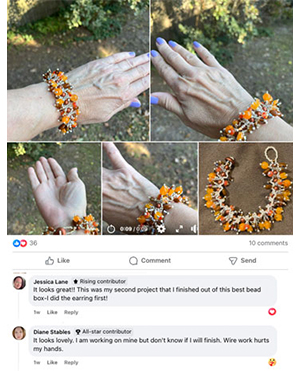- Jewelry-Making Supplies ▾
Design Jewelry with Confidence!
Seed Beads
Thread, Wire, & Stringing Materials
Athenacast Findings & Components
Everything Else
- Kits & Collections ▾
Assemble Your World
Kits & Collections
- Subscriptions ▾
Want monthly Beading Happiness?
Subscriptions
- Learn to Make ▾
Want to learn more?
- Discounts & Deals ▾
Explore Today's Promotions!
- Jewelry-Making Supplies
- Kits & Collections
- Subscriptions
- Learn to Make
- Discounts & Deals
-
Seed Beads
Thread, Wire, & Stringing Materials
Findings & Components
Everything Else
-
Kits & Collections
-
Subscriptions
- Home
- How to Make Jewelry
- Better Beader Episodes
- Rings: Jump, Split & Soldered …
Rings: Jump, Split & Soldered Rings

Watch the Video Tutorial
Watch the Video Tutorial
Need Any Extra Materials?
Need Any Extra Materials?
Need Any Extra Materials?
Need Any Extra Materials?
Episode Transcript
Episode Transcript
Introduction
In this episode of Better Beader, we explore the versatile world of rings in jewelry making. From jump rings to split rings and soldered rings, these small but mighty components can add a professional touch to your designs. Join us as we dive into the techniques and tips for working with various types of rings, and discover how they can elevate your beading projects to the next level.
Materials Needed
- Jump rings in various sizes (e.g., 4mm, 6mm, 8mm)
- Split rings in various sizes (e.g., 6mm, 8mm, 10mm)
- Soldered rings in various sizes (e.g., 5mm, 7mm, 9mm)
- Chain nose pliers
- Flat nose pliers
- Bent nose pliers
- Flush cutters
- Beading wire or thread
- Clasps (e.g., lobster claw, toggle)
- Charms or pendants (optional)
Step-by-Step Tutorial
- Begin by selecting the appropriate size and type of ring for your project. Consider the weight and style of your design when choosing between jump rings, split rings, and soldered rings.
- If using jump rings, use two pairs of pliers to open the ring. Grasp each side of the opening with the pliers and twist in opposite directions to create a small gap. Avoid pulling the ends apart, as this can distort the shape of the ring.
- If using split rings, use a single pair of pliers to grip one end of the ring. Twist the pliers to create a small gap in the ring, allowing you to attach your components.
- When attaching components to your rings, slide them onto the open ring and then close the ring securely using the same twisting motion used to open it. Ensure the ends of the ring are flush to maintain a seamless appearance.
- If using soldered rings, no opening or closing is necessary. Simply slide your components onto the ring as desired.
- As you build your design, consider the placement and balance of your components. Use a variety of ring sizes to create visual interest and hierarchy within your piece.
- If incorporating charms or pendants, attach them to your rings using jump rings or split rings for added movement and dimension.
- Once your design is complete, attach your clasp of choice using a jump ring or split ring. Be sure to choose a clasp size that complements the scale of your piece.
Customization Ideas & Inspiration
The beauty of working with rings in jewelry making is the endless possibilities for customization. Consider experimenting with different metal finishes, such as silver, gold, or rose gold, to suit your personal style or match your wardrobe. Mix and match ring sizes and types to create unique textures and patterns within your designs.
For a bold statement piece, try incorporating larger, more prominent rings as focal points, and use smaller rings to create delicate accents. Play with color by adding beads or crystals to your rings, or create a monochromatic look by sticking to a single metal finish throughout your design.
Conclusion
Working with jump rings, split rings, and soldered rings is a foundational skill every beader should master. By following the steps outlined in this tutorial and experimenting with the customization ideas shared, you'll be well on your way to creating stunning, professional-looking jewelry pieces.
We hope this guide has inspired you to explore the world of rings in your beading projects. Share your creations with us in the comments below, and feel free to ask any questions you may have along the way. Happy beading!
Join Our Growing Community
Join Our Growing Community




Our Testimonials
Our Testimonials
- 55997 (83.8%)
- 4814 (11.4%)
- 3295 (4.1%)
- 230 (0.4%)
- 124 (0.3%)
- Favorite Reviews
- Highest to Lowest
- Newest to Oldest
- All Ratings
- 5 ★ Reviews
- 4 ★ Reviews
- 3 ★ Reviews
- 2 ★ Reviews
- 1 ★ Reviews
Loading...
Only Visible on Admin Mode
Item Description
Designer's Material List
Project Steps
Select the appropriate gauge and diameter for the ring based on your design requirements.
For jump rings, use two pairs of pliers to open the ring by twisting the ends in opposite directions, avoiding distortion.
Thread the ring through the components you're connecting.
Close the ring by twisting the ends back into place, ensuring a tight closure.
For more durability or specific design needs, consider making your own rings using wire and a mandrel.
Highest Quality
Products
100% Money
Back Guarantee
Fast
Shipping
Best Teaching &
Customer Service
You'll want these emails...
Get Free Projects & Inspiration
Get Free Projects & Inspiration
- Bullet 1
- Bullet 2
- Bullet 3
Copyright © PotomacBeads









